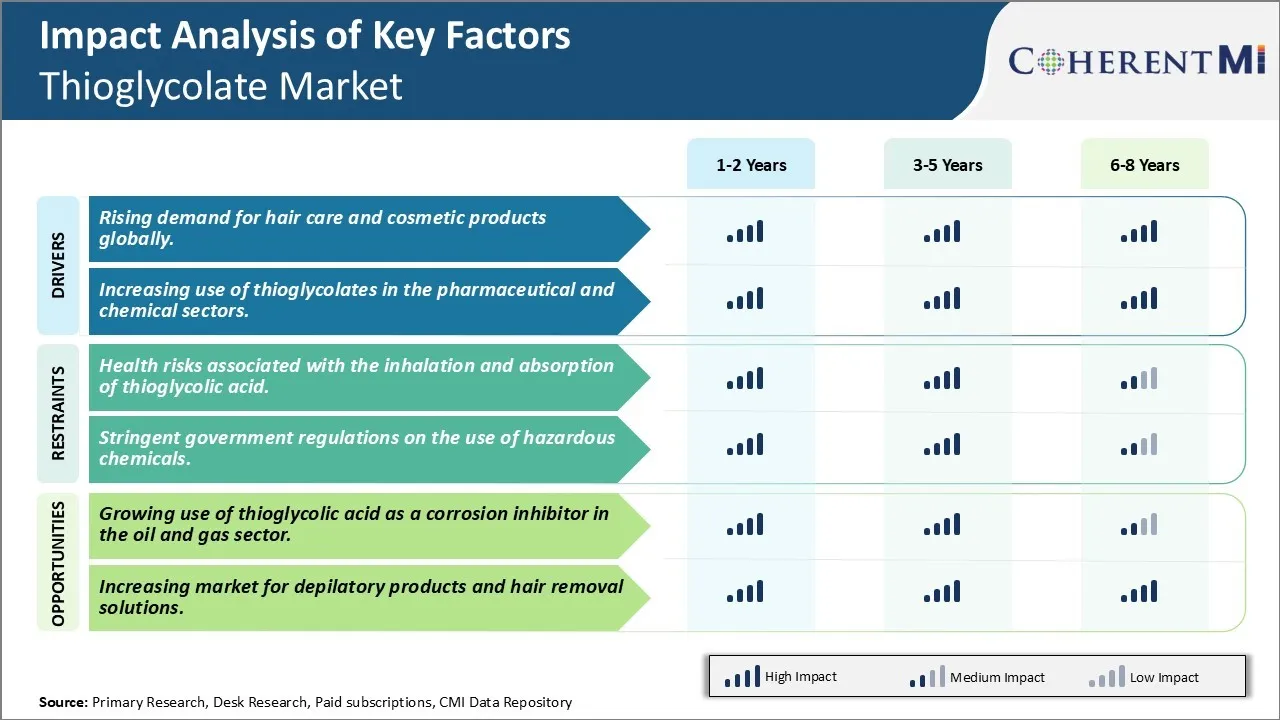Thioglycolate Market Trends
Market Driver - Rising Demand for Hair Care and Cosmetic Products Globally to Fuel Market Growth
The demand for hair care and cosmetic products has seen a significant rise globally over the past decade. Changing lifestyles, increasing disposable incomes and growing focus on personal beauty and appearances have all contributed to this rise in demand from consumers worldwide. Hair care products especially shampoos, conditioners and hair styling products have become a daily essential for both men and women across age groups in many countries now. Their usage is no more confined just for special occasions or weekends.
Thioglycolate is a crucial chemical ingredient that is used in the manufacturing of many hair relaxers and permanents. These types of products that straighten or relax curly and wavy hair see huge demand. With more women and even men joining the workforce and needing easy to manage hairstyles, relaxers and permanents are fast replacing natural hairstyles in regions like Africa, parts of Asia and Latin America. Also, with greater affordability due to growing economies, price sensitive consumers in developing nations are now able to spend more on hair care and looking good. This augments the usage of thioglycolate containing products.
Similarly, cosmetic products ranging from skin lightening creams, facial cleansers, moisturizers, shaving products, deodorants, fragrances are being adopted at an accelerated pace. More women participating in formal education and employment means greater attention to grooming and this catalyzes the sale of such personal care items. Growing media exposure through social media and digital platforms has further ignited novelty seeking and brand conscious tendencies among youth. Companies leverage this by launching new hair colors, nail paints and makeup ranges compelling users to try different looks regularly and keep repurchasing. This consequently stokes the demand for thioglycolate which is widely used as a reducing and stabilizing agent in cosmetic formulations.
With lifestyles evolving at a rapid pace and beauty standards changing dynamically across regions, the worldwide market for hair and skin care products will likely continue its robust growth trajectory over the coming years. This steady rise in consumption and product trials will keep driving greater demand for thioglycolate from manufacturers in the foreseeable future.
Market Driver - Increasing Use of Thioglycolates in the Pharmaceutical and Chemical Sectors Boosts Industry Growth
Besides cosmetic applications, thioglycolate also finds extensive use as a processing aid and intermediate in the pharmaceutical and chemicals industries. It acts as a reducing and stabilizing agent for active pharmaceutical ingredients as well as helps in synthesizing vital chemicals.
Pharmaceutical companies use thioglycolate on a large scale for manufacturing tablets, capsules and other solid dose drug formulations. It prevents oxidation of sensitive molecules during various processing stages like drying, granulation, mixing and tableting. This protects the efficacy and potency of end drug products. Growing incidence of lifestyle diseases and chronic conditions worldwide has resulted in heightened pharmaceutical R&D activities and product development in recent times. Many blockbuster drugs are being regularly discovered and launched in therapeutic categories such as diabetes, cancer, cardiovascular, antibiotics etc. Subsequently, the volume of tablets, capsules and other solid medicines being churned out is increasing every year to meet the treatment needs of global populations. The consumption of thioglycolate as a stabilizing aid by drug manufacturers continues rising steadily to match this escalating production scale.
Apart from pharmaceutical, thioglycolate derivatives play a crucial role as chemical intermediates in various industries including plastics, resins, rubber, leather, paints & coatings, petrochemicals. It is used in synthesis of polymers, plasticizers, emulsifiers and specialist chemicals. Many countries are rapidly industrializing and their manufacturing sectors are fast expanding. China, India, Southeast Asia, Middle East, South America are experiencing double digit growth in key industry verticals annually.

Market Challenge - Health Risks Associated With the Inhalation and Absorption of Thioglycolic Acid.
One of the major challenges faced by the thioglycolate market is the various health risks posed by thioglycolic acid to workers who are exposed to it on a regular basis. Thioglycolic acid is a colorless liquid with a strong unpleasant smell and chemicals containing this acid are widely used in permanents, relaxers or straighteners in hair care products. However, inhalation or absorption of thioglycolic acid vapors can cause serious health issues. Short term exposure through inhalation can cause respiratory tract irritation, nausea, vomiting and headaches. Long term or repeated exposure may lead to more severe effects like asthma, bronchitis and dermatitis. The harmful effects are more pronounced among those working in factories producing chemicals containing thioglycolic acid. Strict safety guidelines and protective measures need to be followed while handling these chemicals but non-compliance remains an issue in some parts of the world. This poses an occupational hazard and makes it difficult to attract workforce, thereby affecting production levels. While innovation in product formulations can help reduce risks, complete elimination may not be feasible. Improving awareness and ensuring worker safety should remain a priority to address this challenge for the sustained growth of the thioglycolate market.
Market Opportunity - Growing Use of Thioglycolic Acid as a Corrosion Inhibitor in the Oil and Gas Sector.
One key opportunity for the thioglycolate market lies in the growing utilization of thioglycolic acid as a corrosion inhibitor in the oil and gas industry. Thioglycolic acid and its derivatives act as an effective corrosion inhibitor for various metals exposed to water and oil-based solutions commonly encountered in oilfield operations and hydrocarbon processing. It helps form a protective molecular layer over metal surfaces to prevent corrosion even in presence of corrosive agents like chloride ions, carbon dioxide or hydrogen sulfide. With rising upstream and downstream oil and gas activities globally, demand for high performance corrosion inhibitors is also witnessing a steady increase. The cost-effective nature and ease of application of thioglycolate-based products is driving their increasing preference over alternative corrosion inhibitors. As oilfield operations move to more challenging environments and continue to age existing assets for enhanced production, the need for advanced corrosion protection solutions will present significant business opportunities for thioglycolate producers in the coming years.